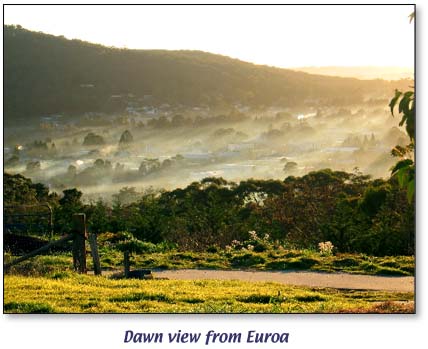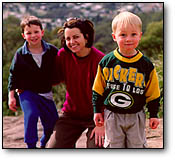The ozline Story – (Tom March since 1998)
The years have passed and life has changed, but our vision and purpose remain as strong as ever: We believe there’s nothing more important than raising and educating children. We pursue this in our personal and professional lives.
You can read the original ozline story which was full of our new life of emigrating to Australia and evolving into new careers.
All the best & thanks, Tom
the ozline story, version 2.0
Welcome to ozline.com. We began life in 1998 as part Web Designer / part educational consultant.

When ozline.com started, we grew by designing Web sites for clients in the educational world – from professional associations and school districts to non-government organizations like UNICEF.
On the sixth anniversary of ozline.com we were finally positioned to focus exclusively on serving the needs of school educators. We have appreciated our Web design clients and will continue to serve longstanding partners, but we now turn our attention on our specialty: helping educators help students.
We can make this total shift to serving K-12 educators because ozline.com has completed development of a comprehensive set of strategies, tools, and software environments that support the range of educators who use the Web to teach students. Below is a synopsis of each of the key pieces.
A Decade of Serving Education – 1995 – 2005
- 1995 – WebQuests
- Tom March was fortunate to team-teach with Bernie Dodge when he proposed the “WebQuest” in February 1995. Tom created the first WebQuest for public use – Searching for China – and continues to evolve his approach.
- 1996 – Activity Formats
- As a classroom teacher, Tom knew that we have a variety of learning goals so he developed other Activity Formats such as the Topic Hotlist, Subject Sampler, Knowledge Hunt, etc. to complement the WebQuest’s inquiry learning goals.
- 1997 – Filamentality
- Once we had an array of different formats or templates to guide teachers’ integration of the Web, we knew there were a few more hurdles facing them. So Jodi Reed and Tom created Filamentality to help educators create, Web publish and post activities without ever leaving a Web browser.
- 1998 – In-person Keynotes and Workshops
- Beginning in 1998, Tom makes an average of one keynote or workshop per month, usually in the Us and Australia. These efforts combine well-founded learning theory with practical approaches that participants can use immediately.
- 1999 – Articles – Working the Web for Education
- In the first of 2 years’ worth of monthly columns in Multimedia Schools Magazine, Tom outlined The Ten Stages for Working the Web. He had observed important milestones that help educators succesfully integrate the Web into classroom learning.
- 1999 – Web-and-Flow
- Taking what we had learned from Filamentality, Jodi and Tom developed Web-and-Flow to provide more comprehensive support for the Web-using educator. We added a “Creative Brief” that acts as a front-end analysis / teacher’s guide, two more Activity Formats, prettier pages and unique evaluation rubrics for all six formats.
- 2002 – BestWebQuests
- As “WebQuest” came to refer to any Web-based activity, it began to lose its effectiveness as an inquity learning process. The single most critical attribute of a WebQuest is that it prompts students to transform what they have learned, to construct new meaning, to develop a more sophisticated understanding. BestWebQuests.com is a highly selective collection of WebQuests that do just that.
- 2003 – Powered by Web-and-Flow
- As individual educators got better at integrating the Web, we turned to address the most important aspect of diffusion: how do we get the majority of teachers to adopt and adapt compelling Web resources into regular classroom practices? By licensing Web-and-Flow as a “Powered by” option, groups like schools, associations and regions can develop their own Web-based curriculum.
- 2004 – BWQU at Edge-ucator.com
- Our goal at ozline.com has always been to “Help Educators Work the Web.” Freely accessed articles and starter software like Filamentality have been available since our earliest days. To assist the ongoing needs and PD of intermediate Web educators, Tom leads in-person sessions and provides Web-and-Flow as a cost-effective supplement. BestWebQuests is intended to inspire advanced tech-savvy teachers to reach their potentials, but until now, we didn’t have a means to reach and teach cutting edge-ucators. With edge-ucator.com, we can now assist groups of learners in an online environment. But rather than float a generic online course, Tom co-designs and schedules online workshops to suit client groups from schools, districts, regions and associations.
- 2006 – The 2nd 10, aNew3Rs, ClassActPortals & The New WWW
- 2006 has seen a flurry of new developments – both in terms of writings and software. Following on the Drive for 2005, the 2nd10 is a call to long-term action, inviting all educators to experiment with the power of digitally enhnaced learning. The best strategy to support this initiative is the ClassAct Portal (see Why ClassAct Portals). Why the burning necessity to transform education from our familiar factory model? The New WWW is on its way!
How Can we Serve you?
- On the Personal Side
- The above steady progression of development has an obvious hole in the years 2000 and 2001. In May, 2000, we lost Lisa Jensen and the following year, Tom followed through on our dream of building a home on our seven acres of bushland. This is mentioned out of respect and also an indicator that while we intentially slowed our pace to take care of important family matters, the boys and Tom are fine and blessed to live in “Euroa” (a joyful place).

Our Web presence is inspired by the artistry of Michael John March.The work we do is dedicated to the life and memory of my wife, Lisa Jensen – the loving mother of our sons.
They make us who we are.
We enjoy a renewed appreciation of life and the special bond of family and friends.Thanks for your years of support.

